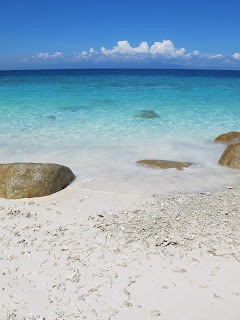In addition to enjoying the soul
soothing island of Leng Tengah, we also squeezed in some sightseeing and
cultural experiences on the mainland of the state of Terengganu thanks to the
kindness of some wonderful Rotarians.
Terengganu is one of the most ethnically Malay states in the country and
we spent some time in the capital of Kuala Terengganu (population: 360,000). It was nice to experience a quiet, more laid
back side of Malaysia.
 |
| Coastline of Kuala Terengganu |
Before the island we visited the
Terengganu State Museum which is touted to be the largest museum in SE
Asia. We only had a few hours so we didn’t
get to see every exhibit, but there were wonderful and informative displays of
textiles (history of batik), royal regalia, crafts, and a important historical artifact-
a stone carved with Jawi (traditional Malay text) that dates the arrival of
Islam to the nation. Replicas and
statues of this stone are seen all over the town in traffic circles, parks,
etc. We practically had the entire
museum to ourselves.
 |
Terengganu State Museum
|
Rotarians were so helpful in
transporting us around, sharing their knowledge, and treating us to local
food. It wouldn’t have been possible
without them as K. Terengganu is practically void of taxis. I can’t help but include this photo of a
typical Malaysian dessert which I believe is called ais kacang (bean ice) or 'ABC' (acronym for Air Batu
Campur meaning
‘mixed ice’). It can come in a variety
of forms but its basically shaved ice with red beans, sweet corn, grass jelly, and
can also include cendol, evaporated/condensed/coconut milk, and then drizzled
with some kind of sweet syrup. Needless
to say, I did not order this concoction, but I have indulged in tastings.
 |
| Ais kacang |
On our way back through town from
the island, I had a chance to visit Taman Tamadun Islam, the world’s first
Islamic civilization park. It seemed so
odd that I couldn’t pass it up. It is
essentially a series of miniature models of famous Islamic landmarks from
across the world. Where else can you see
the Taj Mahal (India), The Sacred Mosque (Mecca, Saudi Arabia), and the Minaret
(China) all in one location? There were
20+ replicas, most of them were just replicas of the outside, but a few you
could go inside and were complete with stain glass and all. There were informative sign boards, but they
mostly discussed the architecture of the mosques and I felt they could have
given more context and historical details for someone who isn’t all that well
versed in Islam as it exists around the world.
The park was big enough that I rented a bicycle for $2USD and cruised
around the quiet park. I was definitely
the only foreigner there and only non-Muslim so I must have looked pretty
strange riding a bike around in the middle of heat of the afternoon in my skirt
with bare legs, but oh well. You can
also take boat rides and enjoy a carousel and other small rides. The brochure calls it a “one stop edutainment
park.” I believe it was constructed
sometime within the last 10 years and was fairly new looking.
 |
| Kul Sharif Mosque, Russia |
 |
| Suleyman Mosque, Turkey |
 |
| Aleppo Citadel, Syria |
 |
| The Sacred Mosque (Masjidil Haram), Mecca, Saudi Arabia |
 |
| Taj Mahal, India |
 |
Dome of the Rock, Jerusalem
This is a shrine built around a rock. According to Islamic tradition, the rock is the spot from
which Muhammad ascended to Heaven accompanied by the angle Gabriel. |
Another highlight right outside
of the park is the Crystal Mosque. It’s
the first and only mosque built from steel and glass which gives it is crystal
like image. Its build on a jetty out
into the Terengganu River and did offer an exhibit with much more information
about Islam. I had to wear a robe and
headscarf to enter and within the 10 minutes I spent inside I probably sweated
my body weight. As I mentioned before, it’s
just getting hotter and hotter here and the temperature was around 34C/93F
outside plus 85% humidity.


Lastly, right before we went to
the airport we joined some Rotarians for a quick visit to the community’s Wesak
Day celebration. Wesak Day is informally
called Buddha’s Birthday as it celebrates the birth, enlightenment, and passing
away of Buddha. We stopped by the
Buddhist Society center where they were preparing for a candle light procession
to commemorate the day with youth and adults from different groups lining up
and distributing candles in lotus flower holders.
Although a quick trip, I really
enjoyed experiencing this edge of Malaysia.
Everyone was so kind, friendly, and welcoming. I hope to visit again as there is definitely
more to see!
Here’s a few more photos from the
island to make you feel warm and relaxed:
 |
| Although very different from Lake Tahoe, some landscapes here reminded me of the beautiful body of water near where I grew up. This scene with the shades of blue reminds me of Tahoe's blue water, and blue mountains, against the blue sky. |
 |
| This pier reminds me of the one below from Nevada Beach at Lake Tahoe. |
 |
| Lake Tahoe |
























































